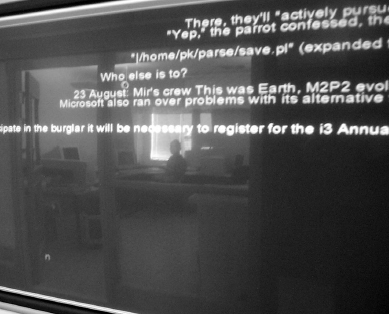處境式方法論
處境視覺化素描(Situated Visualization with Sketching)
處境視覺化是一項新興的資訊視覺化研究領域,將資料視覺化的表現置放在實體空間,
以支援情境中的(in-situ)資料分析。當資料被置放在靠近實體指示對象(referents)附近,
例如人、地方、物件,參與者可以在日常生活中感受到資料展示在實體空間時,
共同生活的親身經驗。Bressa等人(2019)舉辦設計工作坊,邀請參與者用素描和
實體空間置放的方式,建構未來資料與人共同生活的可能情境,如下圖。
應用處境視覺化素描的方式,探索反身性資料、情節式脈絡媒體,
以何種方式出現在日常生活情境中,能夠產生纏結體驗。

處境視覺化素描(situated visualization with sketching),圖取自(Bressa et al., 2019)
Nathalie Bressa, Kendra Wannamaker, Henrik Korsgaard, Wesley Willett, and Jo Vermeulen. 2019.
Sketching and Ideation Activities for Situated Visualization Design. In Proceedings of the 2019
on Designing Interactive Systems Conference (DIS '19). ACM, New York, NY, USA, 173-185.
處境實體化(Situated Physicalization)
為了探索與資料共同生活的設計空間,學者可以創造與資料高度相關的實體化原型,進入生活場域,稱作處境實體化(situated physicalization)(Singhal et al., 2017)。Time-Tuner (見下圖)是一套模擬的智慧型杯墊,讓參與者通過模擬的原型(mock-up)體驗到使用兩個杯墊的互動,影響另一個杯墊上的歷史錄影的選擇和撥放。在設計前期尚未決定如何根據相關資料選擇與播放參與者的居家影片時,處境實體化創造了接近於真實生活感受的物件,邀請參與者共同推測更好的互動方式,例如歷史上相同的日期的影片被播放、一日中相同的時間錄製的影片(如同樣是下午3:00錄下)被播放、播放被置放在相同空中的影片(同樣是在客廳或餐廳中的影片)。
處境實體化原型Time-Turner,圖取自(Singhal et al., 2017)
Samarth Singhal, William Odom, Lyn Bartram, and Carman Neustaedter. 2017. Time-Turner: Data Engagement Through Everyday Objects in the Home. In Proceedings of the 2017 ACM Conference Companion Publication on Designing Interactive Systems (DIS '17 Companion). ACM, New York, NY, USA, 72-78.
處境探針(Situated Probes)
將產品的照片以一比一的尺寸印出,讓參與者在自家空間中置放並推測產品的各種可能用途,
本組曾命名為處境探針(Hsu et al, 2018)。為了研究植物的能動性,以及產品可能體現的植物性,
此探針請參與者將產品照片盡可能在多處空間置放並拍下照片,以探討互動產品與空間的關係。
下圖均為本組曾經發表過的互動設計物,左為Scentonight互動晚安燈,
中為Reflexive Printer反身性印表機,右為InTouch社交溫度互動裝置。
研究過程注重處境植物性(situated plantness),意即,互動裝置的植物性印象,
實際上深受空間環境的影響。
處境探針可以將已完成或正在製作中的設計物,以擬真照片的方式置入生活空間,
邀請參與者進行處境推測。發展更多日常生活與數位空間纏結的處境探針,
使用推測產品照片,推測的產品商標,外掛小物,進行處境纏結探針。



產品照片之處境探針,圖取自(Hsu et al, 2018)
Yuan-Yao Hsu, Wenn-Chieh Tsai, Wan-Chen Lee, and Rung-Huei Liang. 2018. Botanical Printer: An Exploration on Interaction Design with Plantness. In Proceedings of the 2018 Designing Interactive Systems Conference (DIS '18). Association for Computing Machinery, New York, NY, USA, 1055–1068. DOI:https://doi.org/10.1145/3196709.3196809
處境共同推測(Situated Co-Speculation)
訂製小冊(Bespoke Booklet)是推測設計研究者與參與者共同進行處境推測的範例
(Desjardins et al., 2019)。設計師先到參與者的居家拍攝環境照片,帶回工作室進行推測設計,
並將概念產品直接描繪在居家照片上,製作成「訂製小冊」,交回給參與者。
參與者根據自家照片中的推測設計產品,進行共同推測,將意見寫下,
同時也在圖片上加上自己的修改,如下圖。


處境共同推測,訂製小冊(Bespoke Booklet),圖取自(Desjardins et al., 2019)
Audrey Desjardins, Cayla Key, Heidi R. Biggs, and Kelsey Aschenbeck. 2019. Bespoke Booklets: A Method for Situated Co-Speculation. In Proceedings of the 2019 on Designing Interactive Systems Conference (DIS '19). Association for Computing Machinery, New York, NY, USA, 697–709. DOI:https://doi.org/10.1145/3322276.3322311
APP處境推測(& 報紙推測)
李婉貞, 曾綉珍, 梁容輝. 2020. 以報紙為推測素材 :探索居家聯網物件的纏結經驗與多重未來. 台灣人機互動研討會 (TAICHI 2020), Taipei, Oct. 23-Oct. 24, 2020.
物件劇場 (object theathre)
Maria Karyda, Merja Ryöppy, Jacob Buur, and Andrés Lucero. 2020. Imagining Data-Objects for Reflective Self-Tracking. In Proceedings of the 2020 CHI Conference on Human Factors in Computing Systems (CHI '20). Association for Computing Machinery, New York, NY, USA, 1–12. DOI:https://doi.org/10.1145/3313831.3376844
Questions:
How to design situated methodology to deploy your project in the everyday context?
Tarot card deck as a structure for expanding "wabi-sabi" meanings in a constructive way.
1. search "塔羅牌義"
2. extract symbolic meanings of Major Arcana (22 cards)
3. map your associated keywords to the above meanings
4. sort and categorize cards
5. fill out blank card

